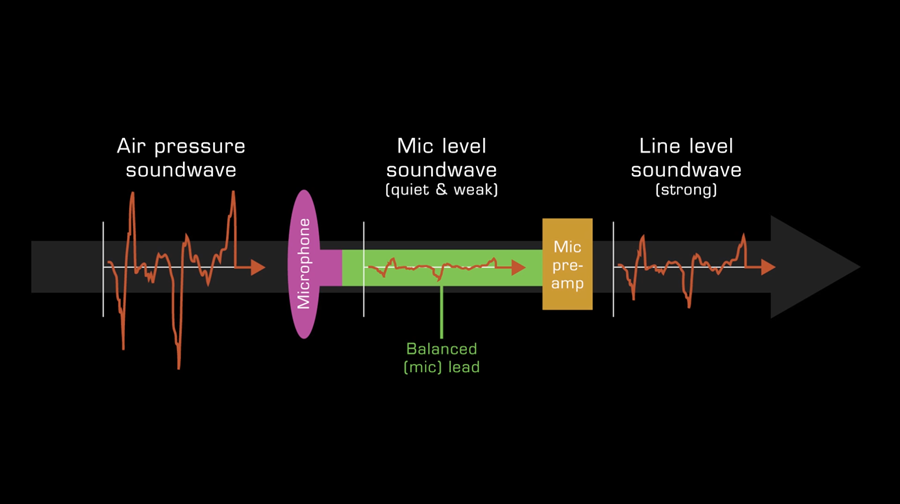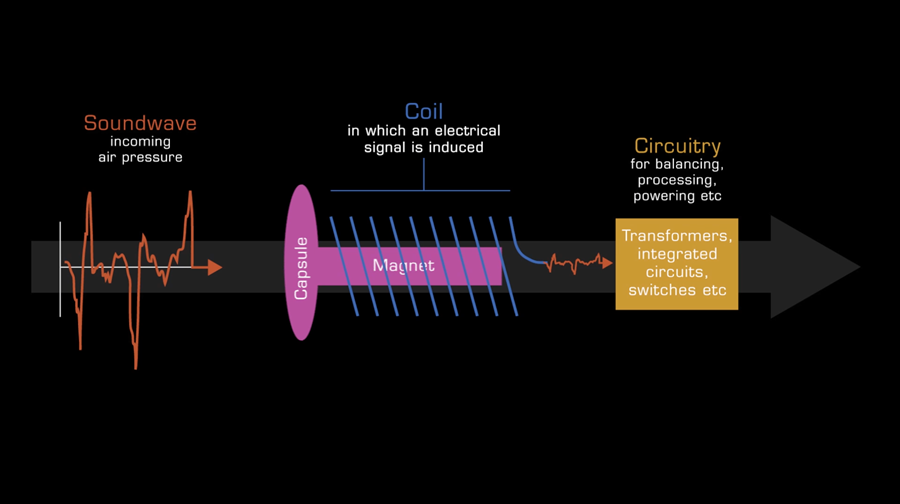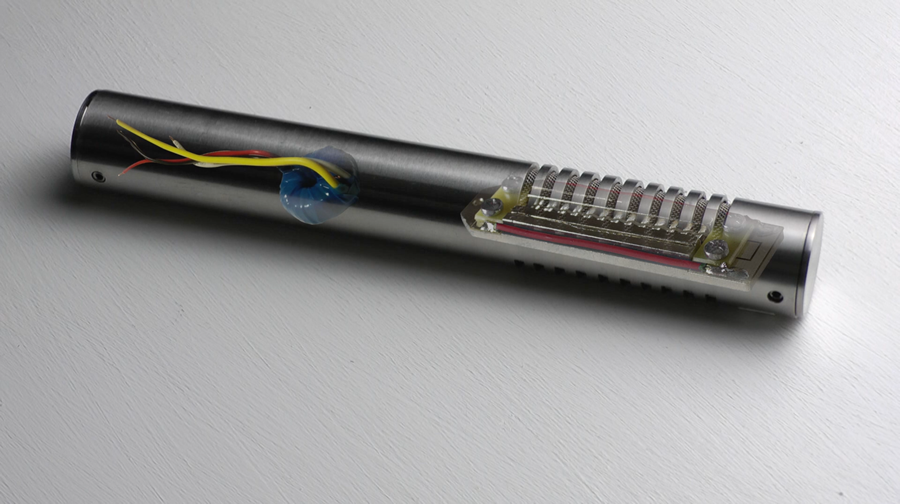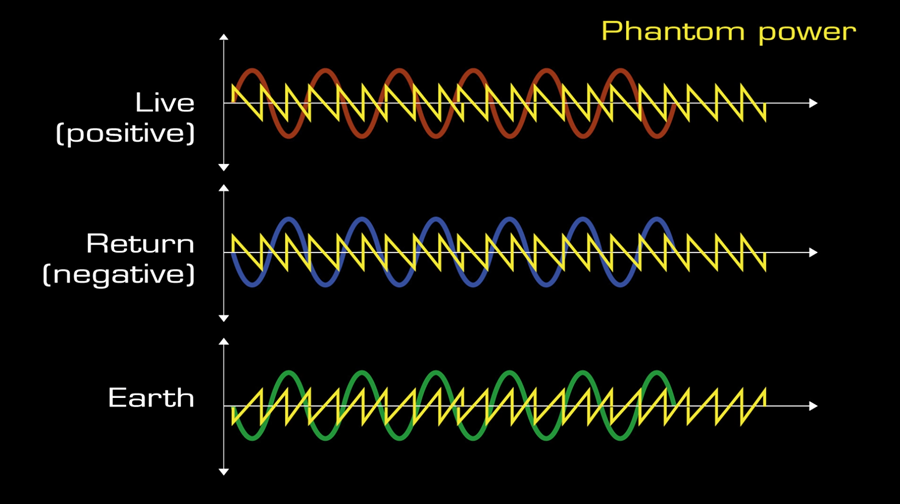Microphones 02
Microphone electronics
- Video
- Script
Welcome to this tutorial on microphones electronics.
Microphones perform an essential role in the recording studio. They convert the air pressure sound waves produced by singers, musical instruments, instrument amplifiers and sound designers into electrical pressure sound waves. The process of tracking a group performance using microphones is still a primary process for many music makers and even the most digitally fabricated productions usually contain at least some tracks recorded with microphones.
Caption - Mic level signals
Microphones, which are also referred to as mics, produce very quiet electrical pressure soundwaves which must be protected from interference by a balanced cable arrangement as they travel to a microphone pre-amplifier. When they arrive at the microphone pre-amplifier the signal is amplified to line level before either being sent to be converted to a digital data stream or converted to a pattern of magnetic flux on analogue recording tape.

Caption - Microphones, transducers, capsules, diaphragms and ribbons
In simple terms, all microphones are transducers. A transducer is a device for converting one form of energy into an electrical voltage. In most microphones the transducer takes the form of an electro magnetic device housed within the microphone capsule.
A simple microphone transducer is comprised of the following elements ..
- A sensitive component, such as a diaphragm or a thin metal foil ribbon, which responds to an incoming air pressure sound wave by moving a magnet
- A surrounding coil which responds to this movement by generating an electrical signal
- Some electronics to power the transducer, balance the signal and send it safely on its way to the microphone pre-amplifier

There are many different types of capsule design and each has its own characteristics and applications. For example ..
- a capacitor microphone capsule is designed to be sensitive and have a wide frequency flat frequency response
- a dynamic microphone capsule is designed to be robust and only pick up sound from nearby at the front
- a omni directional microphone capsule is designed to pick up sound from all directions
.. and .. - a lavalier microphone capsule is designed to be small and unobtrusive and emphasise frequencies common in the human voice
Unless we want to build or modify a microphone, it is not necessary for us to know exactly how these transducers work, but it is important that we understand the characteristics of each type of microphone when we come to choose one for a recording.
Caption - Recording studio microphones
There are many different categories of microphones designed for use in a variety of industries. The three primary categories used in the recording studio take their names from the transducer types they employ. They are ..
- dynamic
- capacitor and back-electret
.. and .. - ribbon
These three microphone types are covered in detail in separate video tutorials.
Caption - Transistors, tubes and ribbons
The specific design of the electronics within a microphone can have a significant impact on the character of the sound it produces.
Caption - Vacuum tubes (valves)
A tube microphone employs vacuum tubes in its circuitry which will typically add pleasing harmonic distortion to the sound. Capacitor microphones with tubes are especially favoured for singers because they can enhance the sound giving it extra dimensions and presence which is often referred to as warmth.
Caption - Transistors (FET)
Microphones that employ FET or Field Effect Transistors in their circuitry are capable of greater transparency and accuracy and are used for capturing the true character of a sound. Both dynamic and many capacitor microphones have these types of circuit.
Caption - Ribbon motors
The transducer within a ribbon microphone is called a motor. Ribbon motors do not necessarily require any electronics, except for a transformer to boost the quiet output from the transducer to a usable mic level signal .

Ribbon microphones are covered in detail in a separate video tutorial.
Caption - Directionality and polar patterns
The specific design of an individual microphones capsule and transducer will determine its sensitivity to sound arriving from different directions. Every microphone will have a polar pattern of directionality and some capacitor microphones are switch-able between two or more patterns.
Polar patters are covered in detail in a separate video tutorial.
Caption - Pad and hi-pass filter switches
In addition to polar pattern select switches, some microphones have circuitry to reduce a microphone's overall sensitivity. A so called Pad switch will allow a microphone to capture a wide range of sound pressure levels without distorting . Pad switches typically allow 10dB of attenuation.
A microphone may also have a high-pass filter switch to reduce rumble and roll off low frequencies typically below 50Hz.
Caption - Powering a studio microphone
Unlike dynamic and most ribbon microphones, capacitor and back-electret microphone have electronics which require external power . This so called Phantom Power may be supplied by a battery, but more typically from a microphone pre-amplifier. The industry standard phantom power voltage is 48 volts and can be sent to a microphone down an XLR cable, from a microphone pre-amplifier, without interfering with the audio signal travelling in the opposite direction.

Capacitor microphone that employ valves in their electronics require more than 48 volts and thus have their own accompanying power supplies which both power the microphone and receive the audio signal before it is sent to a microphone pre-amplifier.
Phantom power is covered in detail in a separate video tutorial.
Caption - Interconnection
All studio microphones utilise the standard 3 pole balanced interconnect arrangement employing suitable cabling terminated in XLR connectors.
The processes for connecting dynamic, capacitor and ribbon microphones are covered in detail in separate video tutorials.
Caption - Impedance and microphone pre-amplifiers (mic pre-amp)
The impedance interaction between a microphone and microphone pre-amplifier can have an impact on the performance of a mic. This interaction is most clearly heard in changes of level and frequency response. Should the mic and mic pre-amp impedances match there will be a severe loss of level and so pre-amps are designed with an impedance typically 10 times greater (1000 to 2000 ohms) than that of mics.
Impedance mismatches between modern dynamic and capacitor mics and mic-pre's are rare and often inaudible. However, ribbon mics have lower impedances and outputs than dynamic and capacitor mics and their frequency response and output level can be greatly effected by many mic pre's. It is therefore advisable to match them with a mic-pre that features circuitry cable of accommodating them.
Caption - Thanks for watching
The script for this video, with accompanying images, can be found at projectstudiohandbook.com
We suggest you subscribe at our YouTube channel, and join our mailing list at our website to receive notification of new videos, blog posts and subscriber only extras.
Thanks for watching.